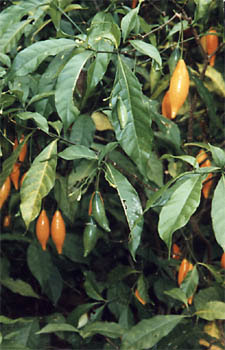
Can a psychedelic shrub diminish drug cravings?
In 1957, two scientists in the research department of CIBA Pharmaceutical Products in New Jersey reported on “an indole alkaloid with central-stimulant properties” used by native peoples in the Congo: “The crude extracts of Tabernanthe iboga caused a feeling of excitement, drunkenness, mental confusion, and, possibly, hallucinations.” The CIBA researchers were working from early reports by French and Belgian explorers in the 1800s, which had noted the use of this remarkable shrub in the Congo and surrounding regions.
Years later, a few researchers had begun to wonder whether ibogaine might not harbor properties that could be used in psychiatry and the treatment of addiction. It was the beginning of an unlikely renaissance in the study of psychedelic drugs.
A little-noticed article in the journal Brain Research in 1994 detailed the results of work with ibogaine at Albany Medical College in New York. Certain mysterious alkaloids—ibogaine in particular—decreased the self-administration of cocaine in rats--presumably through effects on the “dopaminergic mesolimbic system.” It was later determined that ibogaine also exhibited a weak affinity for one of the less common opiate sites, the kappa opiate receptor.
The active ingredient in ibogaine does not produce a classic psychedelic high, even at peak dosages. It is a state more like waking REM sleep, accompanied by hypnagogic images. Some users feel nothing at all, except intense nausea, palsy, and the sound of rushing water in their ears.
In an unexpected return to the psychedelic solution, an odd assortment of ex-hippies, AIDS activists, addiction treatment experts, and maverick scientists fell in behind the use of the African plant drug as a powerful agent for “addiction interruption.” Ibogaine, a drug that Hunter S. Thompson made famous when he joked that it might have been responsible for the downfall of Edmund Muskie’s 1972 presidential campaign, has been cited by some scientists for its ability to free certain cocaine and heroin addicts from their cravings. Initial underground experimentation was aimed at heroin addicts, but the hallucinogenic plant was also tried on alcoholics, cigarette smokers, and cocaine addicts. (The unlikely saga of ibogaine is related in The Ibogaine Story, self-published by Paul De Rienzo and Dana Beal).
Recently, ibogaine gained renewed attention in the usual way—by attenuating alcohol intake in various strains of alcohol-preferring rats. In the January 19 issue of The Journal of Neuroscience, researchers at the University of California-San Francisco (UCSF) reported that ibogaine substantially decreased alcohol consumption in alcohol-preferring rats. It did so by increasing the levels of a brain protein known as GDNF, or glial cell line-derived neurotrophic factor. “By identifying the brain protein that ibogaine regulates to reduce alcohol consumption in rats, we have established a link between DGNF and reversal of addiction,” according to Dorit Ron, the principal investigator of the study.
“On the basis of word of mouth, the ibogaine scene has quadrupled in the last five years,” Ken Alper of the New York University School of Medicine told Science News. In a report published in the Journal of Ethnopharmacology, Alper reported that an estimated 850 people had taken ibogaine in 2001. By 2006, the number had risen to almost 5,000, says Alper—and almost 70 per cent of users had taken the drug for its anti-addiction properties.
Recognition of anti-craving potential for this drug has been understandably slow to reach the mainstream science world. For one thing, ibogaine remains illegal in the United States. No so in Canada, Mexico, and other countries, where ibogaine clinics have begun to appear.
Emerging insights in the brain sciences had changed the field considerably, and, unlikely as it may seem, the proponents of ibogaine managed to catch NIDA’s ear this time around. They also got a running start on some straightforward clinical research from Dr. Deborah Mash of Miami University, who gained approval for clinical trials of ibogaine for the treatment of heroin addiction. Dr. Mash now runs an ibogaine treatment clinic for heroin addicts on the island of St. Kitts.
Taking Ibogaine or any other psychedelic is a strenuous undertaking, involving altered mental states wholly unlike other drug experiences There has never been anything predictable about the results of a psychedelic trip. Since outcomes can vary so markedly, depending upon set and setting, personality, and behavioral traits, studies are difficult to design, and always have been. In the Science News article by Brian Vastag, Frank Vocci, director of anti-addiction drug development at the National Institute of Drug Abuse (NIDA), said that “The idea of trying to push this into pharmaceutical development is a tough nut."
Photo credit: http://www.chm.bris.ac.uk/motm/ibogaine/ibogainej.htm





